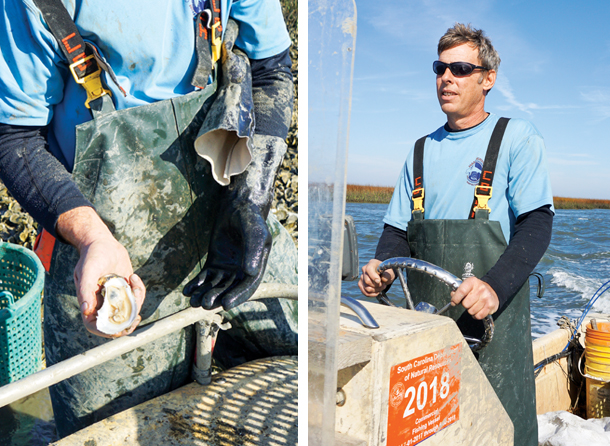
Jeff Spahr (right) and his Charleston Oyster Company harvesting team could easily pick 40 bushels of oysters per day, but they usually stop at 10 to 20 to keep their beds healthy. When hunger strikes, however, a raw oyster makes a fine snack (left). Photographs (2) by Allston McCrady
January 31, 2018
A Day in the Life of an Oysterman
Take a peek into our ultimate Lowcountry Oyster Guide by following Jeff Spahr, owner of Charleston Oyster Company, on a typical day’s harvest
Written by Allston McCrady
- 6:00 a.m.: Spahr hits snooze on his alarm. Repeats three times.
- 6:25 a.m.: Checks weather app and tide charts while coffee brews.
- 6:40 a.m.: Stops by gas station for another cup of coffee on the way to the boat landing. Runs into three oystermen on their day off; hires them to help him wash oysters that afternoon.
- 7:00 a.m.: Puts boat in water at the Cape Romain National Wildlife Refuge.
- 7:15 a.m.: Rounding a bend into Sewee Bay, spots two bald eagles perched on DNR signs.
- 7:25 a.m.: An adolescent dolphin followed closely by its mother beelines playfully towards the boat and dives beneath it.
- 7:30 a.m.: Drives the boat onto a harvested shell bank to spread new shell for future growth.
- 8:15 a.m.: Marks the harvest start time on paperwork (for DHEC compliance), then starts harvesting singles.
- 8:45 a.m.: A curious willet arrives and stakes its claim, fighting off competitors for rights to any oyster scraps.
- 9:30 a.m.: Continues harvesting, tapping apart clusters with a crowbar of choice and wedging market singles loose.
- 10:45 a.m.: Switching beds, Spahr boats past a fisherman casting for whiting in a deep fishing hole; they wave.
- 10:50 a.m.: Checks in with his crew by phone. Each oysterman works his own intertidal bank within the 950 acres of marsh that Spahr leases.
- 11:00 a.m.: Continues “cultivating” beds (i.e. separating and spreading younger oysters to give them room to grow; harvesting larger singles)
- 11:45 a.m.: The rolling wake of a passing boat reveals an alligator lurking just beneath the tide line 30 yards away. Spahr switches locations.
- 12:30 p.m.: Spahr is so focused on work, he forgets to eat the lunch his wife packed for him.
- 1:30 p.m.: Calls his fellow harvesters for a count. Together they have collected 1,400 singles and knocked free more than 3,000 smaller oysters to continue to grow for future harvests.
- 1:45 p.m.: Boating to the mainland, Spahr reminds himself he is lucky to call this his daily commute.
- 2:00 p.m.: Presents paperwork to DHEC and DNR officers patrolling the landing. Both agencies spot-check boats to make sure oysters are being handled properly.
- 2:30 p.m.: Washes the oysters while running them through a custom tumbler.
- 3:30 p.m.: Loose shell and small seed oysters that broke free in the tumbler are re-crated to re-seed oyster beds on the next outing.
- 4:00 p.m.: Calls restaurants to confirm orders and schedule deliveries.
- 5:00 p.m.: Goes home and gets tackled by both of his boys; plays with them until dinnertime.
- 8:00 p.m.: Checks weather and tides before bed.
- 11:45 p.m.: Texts begin flowing in from restaurants post-service, placing orders for more oysters. Spahr replies, “Text me anytime.”
To read the rest of our guide to Lowcountry oysters—including introductions to a variety of locally cultivated singles, a primer on hosting your own roast, and more—click here.
For more from our February issue, click here.
|
 |


